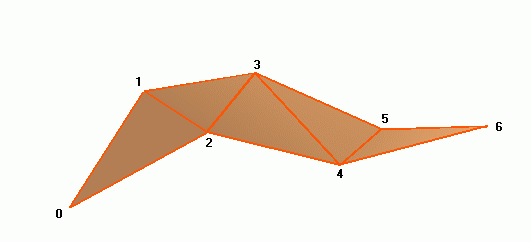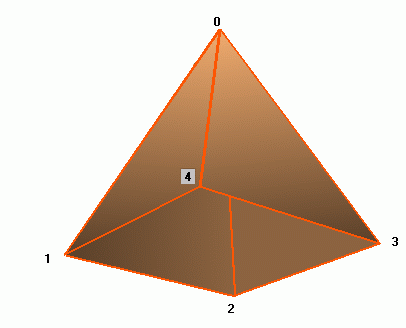 |
This document is archived and information here might be outdated. Recommended version. |
 |
This document is archived and information here might be outdated. Recommended version. |
Provides access to members that identify a MultiPatch and permit controlled access to its parts. Note: the IMultiPatch interface has been superseded byIMultiPatch2. Please consider using the more recent version.
A multipatch is a series of three-dimensional surfaces that are represented as groups of geometries. These geometries may be Triangle Strips, Triangle Fans, or groups of Rings (ring-groups ). In a multipatch there is one triangle strip, or triangle fan per surface, whereas there can be one or more rings per surface. A single multipatch may comprise combinations of triangle strips, triangle fans, and ring groups.
--------------------- Multipatch ---------------------
| | |
Triangle Strip Triangle Fan Rings
Triangle strips are a sequence of connected triangles 0,1,2,3,4,...n that each build from their predecessor.

Triangle fans are a sequence of connected triangles that each use the first point in the sequence as an apex 0,1,0,2,0,3,0,4,...,0,n

Triangle strips and triangle fans specify surfaces by themselves. A ring works contextually with other rings to specify a surface, but it may also be its own surface.
<->
The main difference between the ring and the triangles for a developer is when using
IPointCollection :: GetPoint(index)
for the multipatch.
If the index points to a point in a (segment of a) ring, you get a reference to a copy of the point, otherwise you get a reference to the point directly. This means that you can directly modify points in triangles but in order to modify points in a ring, you must use
IPointCollection :: UpdatePoint
Ring Groups
--------------
Rings all have the same structure, but they have a special role when defining a multipatch surface. The roles of rings are determined by the multipatch (they are not a property of the ring itself)
The roles are called:
One rule that is not enforced, but that should be followed when creating a ring group, is that all rings in a group are co-planar. This is an OpenGL 3D graphics standard.
This means, for example, that a closed cube would comprise six ring groups. Each group would have a single ring. A hole in one of the sides of the cube would not alter the number of groups. Instead, an additional ring would be added to one of the groups to represent the hole.
<->
Another rule is that there is only one group per outer ring. If, for instance, there was another co-planar ring inside the hole mentioned above, this would be represented as another group. This is because it is affectively another surface, even though it is coplanar with the side-ring and the hole-ring.
<->
Each group has a ring sequence, and in combination with the role of the rings in the sequence, a surface can be defined. A multipatch can have a number of surfaces represented by ring groups, the different roles of the rings help to determine the one group from the next, and within each group, determine the structure of the surface.
Following are some examples of using the roles of rings in the ring sequence of a group to define a surface.
---------------------------------------------------------
Multipatch 1 - First Ring designates the start of a ring group. Any subsequent surface other than Ring breaks the sequence.
Triangle strip, triangle fan, ring, ring, ring, first ring, ring
The above sequence is interpreted as five surfaces as follows:
---------------------------------------------------------
Multipatch 2 - Triangle strip, outer ring, inner ring, inner ring, ring, first ring, ring
This sequence is interpreted as four surfaces as follows:
---------------------------------------------------------
Outer ring/Inner ring nomenclature is a more structured form for the surface than First Ring/Ring series. The former explicitly defines that any subsequent inner is a hole in the ring. In the sequence "Inner" must always follow "Outer" or "Inner". It would otherwise be an error. Anything other than "Inner" would stop the sequence for the Inner/Outer group.
| Name | Description | |
|---|---|---|
 |
BeginningRingCount | The number of beginning rings, counting only those of the desired types. |
 |
Dimension | The topological dimension of this geometry. |
 |
Envelope | Creates a copy of this geometry's envelope and returns it. |
 |
FindBeginningRing | Returns the beginning ring of the ring group containing the specified following ring. |
 |
FollowingRingCount | The number of following rings in the ring group that starts with the specified beginning ring. |
 |
GeometryType | The type of this geometry. |
 |
GeoNormalize | Shifts longitudes, if need be, into a continuous range of 360 degrees. |
 |
GeoNormalizeFromLongitude | Normalizes longitudes into a continuous range containing the longitude. This method is obsolete. |
 |
GetRingType | Gets the esriMultiPatchRingType of the input Ring and returns a boolean indicating if that ring is a beginning ring. |
 |
InvalXYFootprint | Notifies the multipatch that its cached footprint has been modified by an outside agent. The footprint will be recalculated the next time it is requested. |
 |
IsEmpty | Indicates whether this geometry contains any points. |
 |
Project | Projects this geometry into a new spatial reference. |
 |
PutRingType | Defines the type of the input Ring. |
 |
QueryBeginningRings | Populates an array with references to all beginning rings of the specified types. This method is intended for internal use only. |
 |
QueryEnvelope | Copies this geometry's envelope properties into the specified envelope. |
 |
QueryFollowingRings | Populates an array with references to following rings that are in the ring group that starts with the specified beginning ring. This method is intended for internal use only. |
 |
SetEmpty | Removes all points from this geometry. |
 |
SnapToSpatialReference | Moves points of this geometry so that they can be represented in the precision of the geometry's associated spatial reference system. |
 |
SpatialReference | The spatial reference associated with this geometry. |
 |
XYFootprint | A reference to a cached copy of the multipatch's footprint in the x-y plane. If the footprint is modified, InvalXYFootprint should be called. |
| Interfaces | Description |
|---|---|
| IGeometry | Provides access to members that describe properties and behavior of all geometric objects. |
| CoClasses and Classes | Description |
|---|---|
| MultiPatch | A collection of surface patches. |